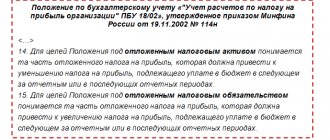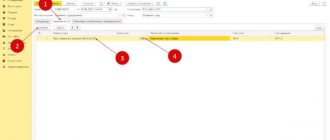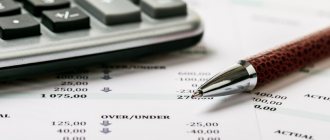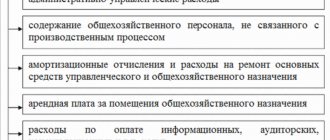Account 09 shows information about deferred tax assets (DTA), which are formed due to differences in tax and accounting accounting, when a difference is formed between the income tax calculated on the basis of accounting and tax data.
The deferred asset that has arisen is taken into account in the debit of the account; in the credit it is repaid. The asset in question is formed and accounted for on account 09 for a separate transaction or operation.
That is, IT is part of the income tax deferred for payment at a later date.
When forming a balance sheet based on the results of the year, the amount of the deferred asset formed during the year and not repaid must be transferred to line 1180 in the amount of the balance in the debit of account 09.
| ★ Best-selling book “Accounting from scratch” for dummies (understand how to do accounting in 72 hours) > 8000 books purchased |
Definition and causes of occurrence
A huge number of companies in the process of carrying out financial and economic activities are faced with such a concept as a deferred tax asset. Such a phrase, at first glance, seems somehow incomprehensible.
If we talk about the nature of account 09, then it is active. The debit part of it reflects the accumulated amounts of deferred tax assets, while the credit part reflects their write-off.
As for the definition of this concept, experts and current legislation explain it as the total difference in income tax, which is formed when a difference arises in accounting and fiscal accounting. The identified deviations according to fiscal and financial reporting data were defined as “deductible temporary differences”, i.e. they take place only for some time.
To put it simply, account 09 forms part of the income tax, which is transferred to the following reporting periods. Thus, companies and organizations postpone for a certain period of time the fulfillment of obligations to pay taxes to the budget.
During the next fiscal period, these amounts are accumulated in item 09 of the balance sheet for each business transaction separately. In this situation, their merging is unacceptable. At the end of this period, the result obtained is transferred to line 1180 of the balance sheet in the non-current assets section.
If we try to identify the reasons that lead to this situation, we should note the following factors:
- the excess of the amount of tax paid to the state treasury over the amount of the accrued liability;
- if, in accordance with the company’s accounting policy, a reserve fund is formed for the payment of vacation pay;
- features of the procedure for making managerial and commercial decisions in fiscal and accounting reporting;
- if the company suffered losses as a result of the sale of the fixed assets.
Examples
Let's prepare an overview of specific situations on the formation of turnover on account 09.
Increase
PJSC "Mask" in accepting income and expenses for the tasks of calculating tax amounts uses the method of accounting for final payment.
On February 10, 2017, the company purchased self-tapping screws from JSC Stolb for the amount of 90,000 rubles, incl. VAT – RUB 13,728.81 Inventory materials are transferred for use in the production process.
Based on the results of the 1st quarter of 2021, Maska PJSC made only partial payment for the supplied screws, namely RUB 70,000, incl. VAT RUB 10,677.97
The tax rate is 20%.
Calculation:
- The accounting records fixed costs in the amount of RUB 76,271.19. (90,000 - 13,728.81).
- In NU the costs amounted to 59,322.03 rubles. (70,000 - 10,677.97).
- We determine the deductible temporary difference - 16,949.16 rubles. (76,271.19 - 59,322.03).
As of April 20, 2017, payment obligations to JSC Stolb were fulfilled in full.
Postings:
| Debit | Credit | Amount, rub. | Business transaction |
| 10 | 60 | 76271,19 | Self-tapping screws accepted for accounting |
| 19 | 60 | 13728,81 | Input VAT |
| 60 | 51 | 70000,00 | Partial payment of goods and materials |
| 09 | 68.04.2 | 3389,83 | The amount of IT increased (16949.16 * 20%) based on the results of the 1st quarter of 2017. |
| 60 | 51 | 20000,00 | Final delivery fee |
| 68.04.2 | 09 | 3389,93 | Closing ONA |
| 99 | 09 | 3389,93 | The amount is written off |
At a loss
The organization Dorma LLC sold a milling machine, which is an operating system, on May 20, 2017. The sale brought the company a negative result in the amount of 210,000 rubles. At the time of transfer of ownership, the remaining useful life was 7 months.
In the accounting system, the existing losses will be attributed to the final economic result immediately in May, and in the national accounting system they will be distributed proportionally over seven months (Article 268 of the Tax Code of the Russian Federation). As a result, the VR is determined in the amount of 210,000 rubles.
From June to December 2021, every month NU will incur expenses in the amount of 6,000 rubles. (42,000 / 7 months).
The write-off of the debit balance from account 09 will be reflected by the following entries:
| Debit | Credit | Amount, rub. | Business transaction |
| 09 | 68.04.2 | 42000 | The amount SHE has been determined (RUB 210 * 0.2) |
| 68.04.2 | 09 | 1200 * 7 | OTA repayment for seven months in a row: June-December 2021 (6000 * 0.2) |
Amount adjustment
Until January 1, 2021, the application of PBU 18/02 was not included in the accounting policy. And as a result of the inventory, I discovered an error in the accrual of OTA in 2021 in the amount of 1000 rubles. A decision was made to make an adjustment in order to correct the accounting and achieve the reliability of accounting information. To do this, the specialist prepares an accounting certificate with the entries: D-84, K-09 for the amount of the discrepancy.
Accrual
Based on the results of work in 2021, it was determined that the financial result of the activities for the year was a loss in the amount of 100,000 rubles. In accounting, cash losses will be reflected on the last day of the current year, and NU will be transferred to the next period.
Posting at the end of 2021 will be:
| date | Amount, rub. | Operation | Debit | Credit |
| 31.12.2016 | 20000,00 | SHE from the amount of loss | 09 | 68 |
Emergence
According to the accounting records of the company DSK for 2015, an amount of fixed assets depreciation was calculated equal to 1 million rubles. At NU, these expenses amounted to 800,000 rubles, and VVR amounted to 200,000 rubles. The company's revenue is 35 million rubles.
The accountant made the following entries:
| Action | Sum | Debit | Credit |
| Profit | 35000000 | 62 | 90.01 |
| Depreciation costs | 800000 | 20.01 | 02 |
| Costs - VVR | 200000 | 20 (BP) | 02 |
| Write-off of expenses | 800000 | 90.2 | 20 |
| Closing of VVR | 200000 | 90.2 | 20 (BP) |
| Fin. result | 34200000 | 90.9 | 99 |
| Calculation of NNP (20%) | 684000 | 99 | 68 (calculation of NNP) |
| Reflection of SHE | 40000 | 09 | 68 |
Write-off
Let's use the conditions of the previous situation and assume that Mars JSC in the 1st quarter. 2021 reached a profitable result with the amount of 1 million rubles. It was decided to reduce the tax amount due to the loss of the previous year:
| date | Amount, rub. | Operation | Debit | Credit |
| 31.03.2017 | 20000,00 | Repayment of ONA | 68 | 09 |
Account balance
If at the end of the reporting period there is a balance on account 09, this means that part of the tax has not been repaid, for example, if the company has made a loss for the second reporting period in a row, there is no tax amount to pay and it is not possible to apply the tax. Then the losses are transferred to subsequent, perhaps more successful periods for the company.
Calculation procedure
Speaking about the deferred tax asset (DTA), it should be noted that it is calculated according to the following scheme:
SHE = expenses that are taken into account in the financial statements in the current period, and in fiscal accounting in the future period x income tax rate.
The amount obtained using this formula should be recorded in the debit part of the balance sheet position indicated above.
If it turns out that tax expenses are generated from an accounting point of view, then the opposite situation will arise and fiscal profit with tax will become less than accounting profit. In this case, the ONA is repaid. A similar situation arises if fiscal income is subsequently recognized in the financial statements.
In order to calculate the amount to reduce OHA, the following formula is used:
Amount to be repaid = expenses that were written off in the financial statements in the previous period, and in tax accounting - in the current period x corporate income tax rate.
According to the second formula, the amount received will be reflected in the credit part of the 09 account. In this situation, the deferred fiscal asset accumulated through a separate operation will be fully repaid over time.
Special conditions for write-off
Important! When an enterprise switches to a simplified tax regime (STS), the accountant needs to know that the 09 account will no longer be maintained. Companies using the simplified tax system are not subject to income tax.
The conditions for transferring the regime are specified in Art. 346 clause 25 of the Tax Code of the Russian Federation. If before the transition the company was in general mode, then it is necessary to close all balances of ONA. Switching to a special regime is allowed from the beginning of the next reporting year. Accordingly, as of December 31, it is necessary to carry out the following operation:
- Dt 99 “Profits and losses” Kt 09.
The entry will close all SHE so that the account is closed on January 1st. When company 09 is liquidated, the account is written off with the same entry. The accounting department always has a question: when should it be written off during the liquidation process? Usually, before drawing up a liquidation balance sheet, a company tries to pay off its obligations as much as possible and collect receivables.
If all the necessary actions have been taken, but SHE will no longer be compensated, then you can write it off.
Formation of deferred tax assets upon sale of fixed assets
Provided that this business transaction is not related to the main activity of the company, funds from the sale of fixed assets are reflected in the credit part of account 91, and in the debit part costs in the form of the residual value of fixed assets.
If it turns out that the balance on the debit side exceeds the credit balance, then the result from the sale of property will be a loss.
According to accounting rules, this result should be taken into account immediately, but according to fiscal law it should be written off in parts every month throughout the entire period according to the following formula:
Duration (in months) = Useful life – The actual period of operation of the property.
This indicator is calculated from 1 month after the object was registered and ending with the month of its implementation.
Typical types of assets and liabilities with accounting accounts and analytics (from the SPP code)
| Types of assets and liabilities | Accounts | Subconto | A comment |
| Accounts payable | — | — | // automatic calculation of SHE and IT is not performed!!! |
| Profitable investments in material assets | — | — | // automatic calculation of SHE and IT is not performed!!! |
| Current period loss | — | — | // Calculation using a special algorithm |
| Fixed assets | 01, 02.01 | Fixed assets | //Fixed assets |
| Fixed assets | 10.MC | Nomenclature | //Assets recognized as inventories in accounting records and fixed assets in accounting records |
| Fixed assets | 02.02, 03 | Fixed assets | //Profitable Investments in_MC |
| Intangible assets | 04, 05 | Intangible assets | |
| Equipment | 07 | Warehouses, Nomenclature | |
| Fixed assets | 08.01 | Construction objects | |
| Fixed assets | 08.02 | Construction objects | |
| Fixed assets | 08.03 | Construction objects | |
| Fixed assets | 08.04 | Warehouses, Nomenclature | |
| Fixed assets | 08.05 | Intangible assets | |
| Fixed assets | 08.08 | R&D expenses | |
| Fixed assets | 08.11, 08.12 | — | |
| Materials | 10.01, 10.02, 10.03, 10.04, 10.05, 10.06, 10.08, 10.09, 10.10 | Warehouses, Nomenclature | |
| Materials | 10.07 | Counterparties, Nomenclature | // Materials in processing |
| Materials | 10.11 | Nomenclature | // Materials in use |
| Unfinished production | 20.01.1, 23.01, 28.01, 29.01 | Divisions, Nomenclature groups | |
| Indirect production costs | 20.01.2, 23.02, 25, 26 | Expenditures | |
| Unfinished production | 20.02 | Nomenclature | |
| Finished products | 43 | Warehouses, Nomenclature | |
| Semi-finished products | 21 | Warehouses, Nomenclature | |
| Future expenses | 97 | Future expenses | |
| Goods | 41 | Warehouses, Nomenclature | |
| Goods shipped | 45 | Nomenclature | |
| Goods shipped | 45.04 | Counterparties, Fixed Assets | // Fixed assets shipped |
| Distribution costs | 44 | Expenditures | |
| Financial investments | 58.01.1 | Counterparties | |
| Financial investments | 58.01.2, 58.02 | Counterparties, Securities | |
| Financial investments | 58.03, 58.04, 58.05 | Contractors, Agreements | |
| revenue of the future periods | 98 | — | |
| Exchange differences for calculations in USD | UE.60 | Contractors, Agreements | // Exchange differences when paying in rubles (passive accounts) |
| Exchange differences for calculations in USD | UE.62 | Contractors, Agreements | // Exchange differences when paying in rubles (active accounts) |
| Shortages and losses from damage to valuables | 94 | — | |
| Estimated liabilities and provisions | 96 | Estimated liabilities and provisions | |
| Provision for doubtful debts | 63 | Contractors, Agreements | |
| Accounts receivable | 62.OS | Contractors, Agreements | // Accounts receivable from the sale of fixed assets requiring state registration |
Examples of transactions on balance sheet item 09 from practice
Let's imagine that there is a certain enterprise that has sold a fixed asset. The loss from the sale of property amounted to 120,000 rubles. At the time of sale of the OS, its remaining useful life was 7 months.
If we talk about accounting, then the resulting loss should be reflected in the financial results of the reporting month in which the transaction was made. As for fiscal accounting, these costs should be written off gradually over the entire remaining service life, i.e. for 7 months.
Starting from the next month after the implementation of the operating system, the enterprise should include 3,428.6 rubles in monthly expenses. (24,000 / 7 months).
As for the accounting entries, they looked like this:
- Dt 09 - Kt 68.04 - 24,000 rubles, the amount received ONA (120,000 x 20%);
- Dt 68.04 - Kt 09 – 685.72 rubles, monthly partial repayment of deferred tax;
- Dt 09 - Kt 09 - 20,571.4 rubles, the resulting difference between the revolutions.
The resulting amount of the difference between turnover should be reflected in line 141 of the financial results statement for the reporting year.
Balance sheet reform: closing 2011
Not only participants or shareholders, but also the state have the right to claim part of the company’s profits. His right to a share in the business is enshrined in the Tax Code of the Russian Federation. How? It’s very simple: organizations are required to pay some taxes using their profits. In the most general of the meanings, balance implies a certain balance on a certain day, a difference. We will dwell on the types of balances a little later, but now we will look at examples of the meanings of this word in different areas.
Well, maybe I don’t know how to look, of course. Now I’ll redo everything again and do a new closing for the month (namely, with the cancellation of the closing). In the end, I hope to see the same result. So you write first in a sentence, what has already helped you, why are you planning to retransmit it again? Anonymous 03/25/2014, 09:41 It seemed to me that this was a reproach, that I was trying to ensure that everything was clear?
Online cash register: who can take the time to buy a cash register Individual business representatives may not use online cash register until 07/01/2019. However, for the application of this deferment there are a number of conditions (tax regime, type of activity, presence/absence of employees).
Posting contents debit 99 credit 99
Posting Dt 99 Kt 99 is formed once at the end of the year when summing up the results and is part of the balance sheet reformation.
In fact, this is an operation consisting of several entries Dt 99 Kt 99 inside account 99 “Profit and Loss”, depending on the number of subaccounts. The operation in practice is called “Closing accounts”. It consists of assigning the values accumulated in subaccounts to one subaccount, which reveals the final annual financial result.
To understand how this happens, you need to familiarize yourself with the internal structure of account 99 and consider how subaccounts are opened for it.
Regulatory framework for accounting for temporary differences
The rules for calculating income and expenses in accounting are prescribed in PBU 9/99 and 10/99, respectively. And the requirements for tax accounting of these transactions are voiced in Chapter 25 of the Tax Code of the Russian Federation. Unfortunately, the rules for recording income and expenses for income tax purposes often differ from accounting requirements. In this regard, differences arise, which in 2002 legislators prescribed in PBU 18/02. This document explains the concepts of permanent and temporary differences.
Read about permanent differences in the article “A permanent tax asset is...”.
The provisions of this regulatory act apply only to those organizations that apply OSNO, but are not credit institutions or government organizations.
Small enterprises and non-profit organizations, if they have decided to use simplified accounting methods, have the right not to use the norms of PBU 18/02. But this right should be recorded in the accounting policy.
Clause 3 of PBU 18/02 states that a legal entity must independently determine in what order to take into account permanent and temporary differences. As one of the options, the legislator provides for the possibility of reflecting data on accounting accounts based on primary documentation. The chosen procedure should be described in the accounting policy.





